Sarah Browning, Nebraska Extension Educator

"Poison hemlock flowers" by Oregon Department of Agriculture, CC BY 2.0
There has been great concern in recent weeks from home gardeners about poison hemlock, also known as poison parsley. Botanically known as Conium maculatum, poison hemlock is blooming right now with large flat clusters of white flowers so can be easily spotted.
Poison hemlock is native to Europe, northern Africa and western Asia. It was introduced to North America in the 1800s as a garden ornamental and marketed as a “winter fern”. It is now naturalized throughout most of North America, including the entire state of Nebraska, often found along roadsides or in unmanaged areas such fence lines, windbreaks or field edges. It prefers shaded moist areas and does not tolerate mowing well, which can be used to aid in control.
The plant is infamously reputed to have been the cause of Greek philosopher Socrates death, his chosen poison when sentenced to execution under Athens law. All parts of the plant are toxic, containing several closely related pyridine alkaloids – naturally occurring organic compounds found in some plants.

Lifecycle
Poison hemlock is a biennial, germinating from seed in spring and throughout summer. First year plants are short, growing into a small bushy rosette of fern-like foliage. The following year, plants begin sending up a flower stalk in late April/early May which can reach up to 6-10 feet in height. Plants bloom in June and July, set seed then dry out and die as the summer progresses. The plant’s taproot dies along with the foliage. Reproduction is only via seed.

Identification
Leaves have alternate arrangement on stems, although they may be oppositely arranged on the upper stems. The foliage is bright glossy green and finely divided (bipinnately compound) similar to carrot foliage. Leaves are smooth and hairless. On the lower leaves, petioles are long and their bases wrap around the main stem. Upper petioles are shorter and may not sheath the stem.

Three main identification characteristics – stems are hairless, hollow between nodes, highly branched, with reddish-purple streaks or splotches. Stem coloration is often very faint in young first year plants, so inspect non-blooming plants carefully.
Blooms are composed of many clusters of tiny 5-petalled white flowers, creating showy flat-topped flower heads.
Look A-likes
- Queen Anne’s lace, aka wild carrot (Daucus carota) – no purple mottling on stems; usually 3 feet or less in height; white hairs on stems; blooms from June through September
- Wild parsnip (Pastinaca sativa) – no purple mottling on stems; stout grooved stems; yellow flowers; blooms May to July
- Water hemlock (Cicuta maculata) – does have purple mottling and hollow, hairless stems, but foliage is much coarser and not fern-like; also, unlike poison hemlock, has a cluster of fleshy taproots at the base of the plant; blooms July to September
Toxicity
All plant parts are toxic; dead canes can remain toxic for up to three years. Mature seeds are the most poisonous. Eating plant parts is the main danger to both humans and livestock, but sap can cause skin rashes and toxins can be inhaled affecting the respiratory system.
Control
Use the same precautions when working with poison hemlock, that you would use with poison ivy. A simple touch to a stem or flower won't kill you, but sap on your skin could give you a rash. People with a history of severe allergic reactions should be especially careful. Always protect yourself by wearing chemical resistant gloves, long sleeved shirt, long pants, shoes and socks. Small infestations can be pulled by hand or removed with a shovel. Large infestations can be cut down with a string trimmer. Be careful when using and cleaning equipment to keep sap off your skin.
Plant debris should be bagged, the bag tied closed and disposed of in the trash. Or pit compost plant debris by digging a deep hole and burying plants where they will not be disturbed or seeds able to germinate.
- Don’t burn dead plant material as toxins can become airborne.
- Don’t add plant debris to a compost pile.
- Don’t leave plant debris where children or livestock have access to it.
Herbicide applications are most effective on 1) young seedlings, 2) in fall when 1styear plants are in the rosette stage or 3) in early spring on 2ndyear plants before flower stalk development begins. Do not use herbicides on large mature plants; instead cut off the flowers to prevent seed development, mow large plants down and use herbicides to kill the first-year plants. Keep children and livestock away from areas where plant debris is left on the ground.
Selective broadleaf herbicides
- Residential landscapes – 2,4-D, dicamba, triclopyr
- Livestock producers – 2,4-D ester + dicamba, Grazon P+D (picloram + 2,4-D), Streamline (aminocyclopyrachlor + metsulfuron)
In addition to the products above, the non-selective herbicide glyphosate (RoundUp) is also effective but should be used carefully to minimize damage to turfgrass or other desirable ornamental plants.
Legal Status in Nebraska
Poison hemlock does not have noxious weed status and is not a legally regulated plant in Nebraska. Plants or infestations do not need to be reported. Control is not required but is encouraged.
References
Lingenfelter, D., & Graybill, J. S. (2022, June 12). Poison Hemlock: Facts About this Early Season Weed. Penn State Extension. Retrieved June 28, 2022.
Poison-hemlock identification and control: Conium maculatum - King County. (2019, January 19). King County, Washington State. Retrieved June 28, 2022
Reeves, K. (2010).Exotic Species: Poison Hemlock. National Park Service. Retrieved June 28, 2022.
Stubbendieck, J. L. (2003). Weeds of the Great Plains. In Poison hemlock (3rd ed., pp. 44–45). Nebraska Department of Agriculture.
Images
- "Poison hemlock stem" by Oregon Department of Agriculture, CC BY 2.0
- Young poison hemlock plant with only slight red-purple markings on the stem. Robert Vidéki, Doronicum Kft.,Bugwood.org
- Water hemlock foliage (left) compared to poison hemlock foliage (right). Steve Dewey, Utah State University,Bugwood.org
Search Our Archive
Associated Video
Poisonous Plant ID
Nebraska Extension Educator Terri James and Nebraska Extension Landscape Horticulture Specialist Kim Todd look at home landscape vines and shows the difference between them and poison ivy.